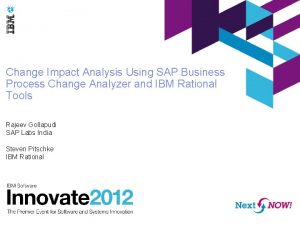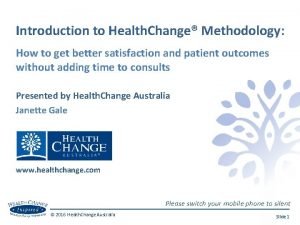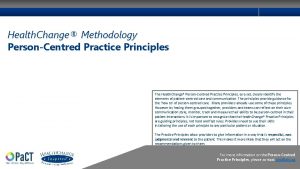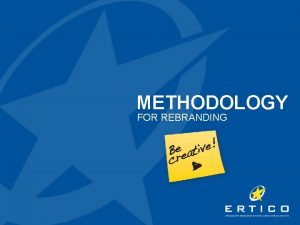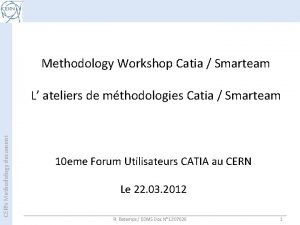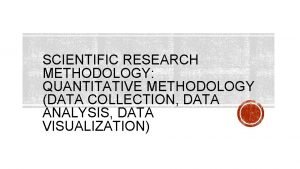Change impact analysis Change Impact Analysis Methodology The











- Slides: 11

Change impact analysis

Change Impact Analysis Methodology The Change Impact Analysis tool highlights the impact of change on the organisation by contrasting employees’ ‘current’ and ‘to-be’ states in relation to people, process, location, operational performance, regulation and technology use. The tool should be used at the Initiate stage of any proposed changes to the organisation’s processes. This will ensure that the impact on employee groups is understood from the outset, help minimise business risk and maximise the success of sustained implementation. Using this tool will help to • Gain an early view of what changes to processes will mean for the people • Give an early view of the individual / group with the highest impact from proposed changes • Highlight potential change impact ‘hot-spots’ to guide the focus of communications and interventions • Highlight key stakeholders to effectively manage throughout proposed changes and their implementation Hints & Tips ► One person should have responsibility for populating the tool. ► To complete the tool run focused ‘interviews’ or small working sessions to complete the fields. ► Ensure the interviewer ‘probes’ the individual or group on the areas of impact being assessed (people, process, location etc. ). A useful question to ask is ‘if this change were to be implemented tomorrow, what would it mean for the function / individuals / teams (etc. )? ’ ► When interviewing, ensure that you make a distinction between the ‘current’ state and the ‘to-be’ state. ► Select people from the business who understand the area for proposed change and are of reasonable standing or influence to ensure that the data is valuable and represents the views of others. ► Ensure that the selected people are objective (i. e. not emotionally involved) otherwise there will be a risk of a subjective view being given that is not representative of others. In addition, try to validate the information with the area impacted (wherever possible) to help ensure an accurate view has been capture. © Issoria 2019 2

1. Example guidance - Portfolio Summary Begin by completing a high level overview of the Portfolio to capture the description and key reasons for and benefit from the proposed change. Portfolio: Completed by: Completion date: Case for change Relate to risk management - globalisation and digitisation require more coordination. Vision for the future Paint a concise, but compelling, picture of the future. Journey Describe at a high level the key steps required to implement the changes and what the main practical differences will be. Consider: capability, headcount, big system changes / implementations. Practicalities What will be different in the new world? (e. g. reporting line changes, new governance structures) Benefits to the business What will success look like, both to you and to the wider business? What will be better about how your function will be able to support the business in fulfilling our mission? © Issoria 2019 3

2. Change Impact Analysis template On a project by project basis, capture the main changes and their associated impacts in the template below. The following page has suggested questions to explore the impacts of the changes. PROJECT OVERVIEW CHANGE OVERVIEW DIVISIONS AFFECTED REGION / COUNTRY AFFECTED TIMESCALES Expected start date: Expected end date: Key Milestones: PROCESS (P) LOCATION (L) OPERATIONAL PERFORMANCE (OP) CUSTOMERS, SUPPLIERS, REGULATORS (CSR) TECHNOLOGY (T) Change Impact PEOPLE & ORGANISATION (PO) Rating Key Low no. of people affected & scale of impact © Issoria 2019 Med no. of people affected & scale of impact High no. of people affected & scale of impact 4

2. Example questions / prompts PEOPLE & ORGANISATION (PO) • How many people will • • Change Impact • • Rating • be impacted? Are they specific stakeholder groups? What will be the changes to Roles, Responsibilities & Remit? How will these changes be embedded? Has a RACI been created? Will the reporting lines change? What HR support do you need? Will job descriptions need to be amended? Any new recruits or redundancies? Have you considered the union / involvement? Have you drafted a comms plan? How do you expect people to react to the changes? How are you going to get their views? Are there any lessons learned / previous feedback to use? © Issoria 2019 PROCESS (P) • How many processes are changing? • What are the main differences in the new processes? • Will the new processes be quicker, safer, more consistent? • Will end users be involved in designing / testing the new processes? • Where will process maps be stored? • How, when & who will review and update the processes? • How will you ensure compliance to the new processes? • What training is required to enable people to work in the new way? • Will there be any different boards or committees to engage with? OPERATIONAL PERFORMANCE (OP) LOCATION (L) • Will current people be • Will there be any • Will existing locations be • • Is there sufficient • moving to new locations? receiving new hires? capacity in existing locations for any new hires? • What costs will be associated with adding or removing people from locations? • Have the necessary departments been involved to facilitate any moves? • Will existing teams have a wider geographical remit? • What does this mean for their ways of working, time zones, culture? • Any language implications? • • changes to current metrics / performance measurements? What reporting requirements will there be in the future? What will happen to old reports? How will you transition between the current and future states? Who will review and use the new reports? How will they be trained or involved in building new metrics / reports? Will there be any changes to Service level agreements? How will these be implemented ? What will be the effect on Business As Usual of your proposed changes? Are there any other BAU events happening that may impact performance in the same time period? How will you minimise any interruptions to BAU? CUSTOMERS, SUPPLIERS, REGULATORS (CSR) TECHNOLOGY (T) • Are there any impacts on • What is changing in the new or existing customers , suppliers or regulators? • How will you engage them? • Have you gathered their views or input? • Will they have to change any of their ways or working, inputs or outputs to you as a result of the proposed changes? • Are there any new compliance requirements as a result of your proposed change? technology infrastructure, data & applications? • How will people be trained on new systems? • Will end users be involved in building / testing new technology? • Will current technology issues be impacted by your proposed changes? • What are the impacts on Security? • Will people have access to different resources as a result of the change? 5

Output Change Impact Analysis is a means to an end, identifying the change, assessing its scale and complexity, and assessing the implications thereof, enables: 1. The business to understand own the change and 2. The Programme to provide the right support to equip the business for effectively managing people through the transition The insight gained from the Change Impact Analysis should drive a series of mitigating actions with the goal of addressing the change impact to the end user e. g. training, procedures, communications, etc. The information gathered within the tool can be used to inform the following: • Stakeholder engagement planning. • Communications planning – e. g. giving the business an early view of what the future could look like. • Initial understanding of training requirements for technology and systems. • Initial view of HR procedures – e. g. behavioural ‘watch-outs’, change-resistant employee groups, capability / skill requirements, relocation policies. • A guide to early resource planning on where and how to focus ‘change’ needs. • An early understanding of what it might take to implement the change. • An initial view on the cost to the business – e. g. training requirements or relocation subsidies. The Change Impact Analysis outputs can also be turned into a visual that can be used to help engage your target audiences in the upcoming changes. Examples of potential visual outputs are contained at the end of this toolkit. © Issoria 2019 6

3. Action Plan Template (Example) Turning your identified change impacts into a series of mitigating actions is key to driving change. An example output action template is attached. Add any additional columns or detail you feel are relevant. Ensure these change plan activities are built into your overall portfolio / project plan. Change Impact Area Theme / Insight Ideas to address Next Steps People & Organisation Process Location Operational Performance Customer, Suppliers, Regulators Technology © Issoria 2019 7

4. Visual Summary output (Example) Once you have summarised your Change Impacts, consider if they can be grouped into any themes. The example below, shows how several smaller themes link directly to a larger theme above. This pyramid visual, can help you to communicate to your impacted audience the extent and nature of the proposed change and ensure you focus your mitigating actions in the rights areas. © Issoria 2019 8

4. Visual Summary output (Example) BI GL AR AP Group Summary of changes Summary of changes Themed impacts Themed impacts People Affected (Number & Groups) People Affected (Number & Groups) Timeframe Timeframe Actions / Next Steps Actions / Next Steps © Issoria 2019 9

4. Visual Summary output (Example) Europe Asia ! ! UK ! North America ! ! Middle East People impact ! ! South America Potential Key Themes Africa Oceania xxxx ! Multiple changes affecting at same time Structural changes xxxx System changes xxxxx © Issoria 2019 10

We’re here to help Should you ned help using the tool or would like to discuss anything else with Issoria, please don’t hesitate to get in touch. +44 (0) 203 865 1449 © Issoria 2019 info@issoriachange. com 11

